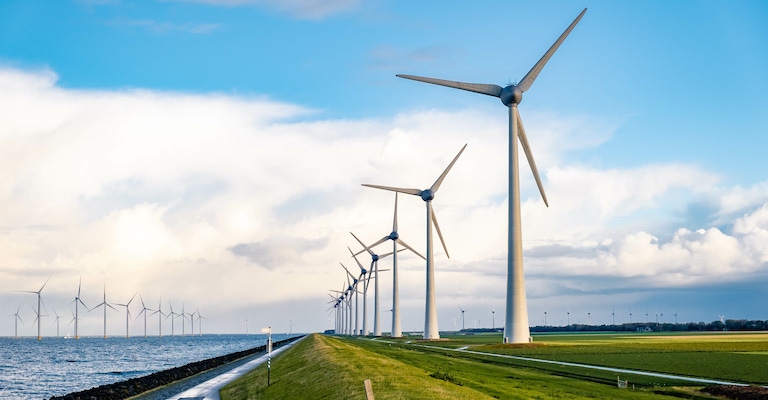2020 Gives Record Growth in Wind Energy: Accounts for 42% of New US Grid Capacity
Three newly-released DOE annual reports provide insight into the growth and scope of wind power in the US.
September 9, 2021

The U.S. Department of Energy (DOE) has released three market reports showing record growth in U.S. wind energy over the past year. The annually updated data track installations, technologies, costs, prices, incentives, and performance for three wind energy market sectors—land-based utility-scale, offshore, and distributed. In 2020, wind energy was the largest source of U.S. electric-generating capacity additions, accounting for 42% of new capacity.
Here are some of the key findings from the reports:
Wind comprises a growing share of electricity supply: U.S. wind power capacity grew at a record pace in 2020, with $25 billion invested in 16.8 gigawatts (GW) of capacity
Wind energy output rose to account for more than 8% of the entire nation’s electricity supply and is more than 20% in 10 states.
At least 209 GW of wind are seeking transmission interconnection; 61 GW of this capacity are offshore wind and 13 GW are hybrid plants that pair wind with storage or photovoltaic (PV) solar power
Wind project performance has increased over time: The average capacity factor among recently built projects was over 40%, considerably higher than projects built earlier. The highest capacity factors are seen in the interior ‘wind belt’ of the country
Turbines continue to get larger: Improved plant performance has been driven by larger turbines mounted on taller towers and featuring longer blades. In 2010, no turbines employed blades that were 115 meters in diameter or larger, but in 2020, 91% of newly installed turbines featured such rotors. Proposed projects indicate that total turbine height will continue to rise
Low wind turbine pricing has pushed down installed project costs over the last decade: Wind turbine prices are averaging $775–$850/kW. The average installed cost of wind projects in 2020 was $1,460/kW, down more than 40% since the peak in 2010, though stable for the last three years. The lowest costs were found in Texas and the (non-ISO) West
Wind energy prices remain low, around $20/MWh in the interior of the country: After topping out at $70/MWh for power purchase agreements (PPAs) executed in 2009, the national average price of wind PPAs has dropped. In the interior ‘wind belt’ of the country, recent pricing is around $20/MWh. In the West and East, prices tend to average $30/MWh or more. These prices, which are possible in part due to federal tax support, fall below the projected future fuel costs of gas-fired generation
The health and climate benefits of wind in 2020 were larger than its grid-system value, and the combination of all three far exceeds the current levelized cost of wind: Wind generation reduces power-sector emissions of carbon dioxide, nitrogen oxides, and sulfur dioxide. These reductions, in turn, provide public health and climate benefits that vary regionally, but together are economically valued at an average of $76/MWh-wind nationwide in 2020
The domestic supply chain for wind equipment is diverse: For wind projects recently installed in the U.S., domestically manufactured content is highest for nacelle assembly (>85%), towers (60-75%), and blades and hubs (30-50%), but is much lower for most components internal to the nacelle
Global offshore wind installations in 2020 totaled 5,519 MW
The U.S. offshore wind pipeline grew 24% over the previous year, with 35,324 MW now in various stages of development
The Bureau of Ocean Energy Management created five new Wind Energy Areas in the New York Bight with a total capacity of 9,800 MW, representing a large portion of the 2020−2021 pipeline growth
Massachusetts' Vineyard Wind I became the first approved, commercial-scale offshore wind energy project in the United States
There are 15 projects in the U.S. offshore pipeline that have reached the permitting phase, and eight states have set offshore wind energy procurement goals for a total of 39,298 MW by 2040
Turbine sizes continued to grow, with average rotor diameters exceeding 150 meters and turbine capacities more than 7.5 MW
The U.S. distributed wind sector—which includes power from wind turbines installed near where the power will be used—added 14.7 MW of new distributed wind capacity across 11 states
U.S.-based manufacturers of small wind turbines (100 kW or less) accounted for 71% of domestic small wind sales capacity in 2020
Intermittent renewable energy sources like wind and solar continue to rely on a variety of energy storage systems including, pumped storage hydropower (water batteries) and electrochemical lithium-ion and flow batteries to store energy for use at night or when the wind isn’t blowing. A new trend that has emerged in 2020 is an increased interest in using offshore wind to produce clean hydrogen by electrolysis of seawater. Renewables along with grid-scale energy storage are the most promising path to a carbon-free electrical power system.
Kevin Clemens is a Senior Editor with Battery Technology.
About the Author(s)
You May Also Like





